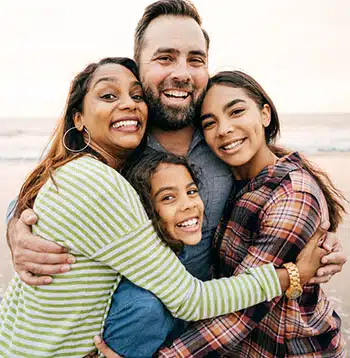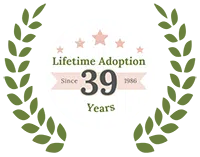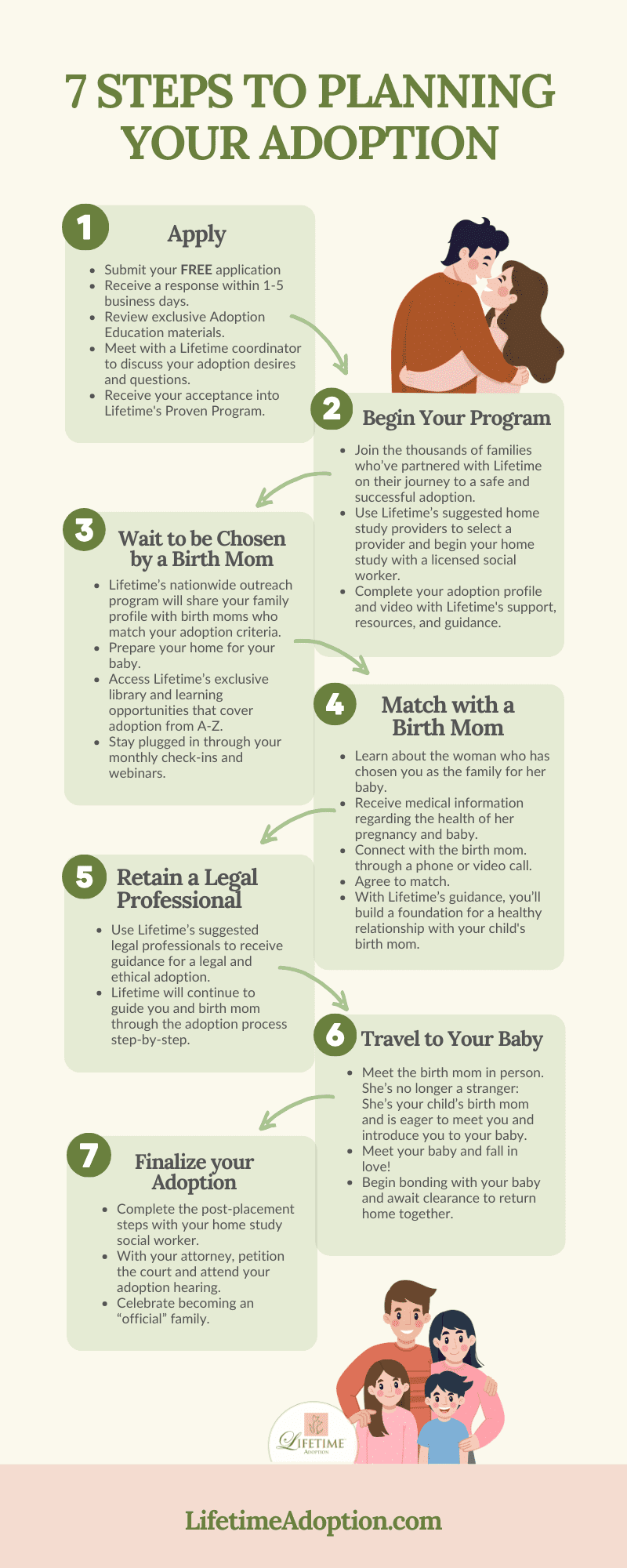How Does the Adoption Process Work?

1:Adoption Process Steps
Apply:
Start by submitting your free application. Expect a response within 1-5 business days.
Dive into our exclusive Adoption Education materials. Then, schedule a meeting with a Lifetime coordinator to discuss your adoption desires and questions. We will answer questions like, “How does the adoption process work?” and any other questions you have. Upon acceptance into Lifetime’s Proven Program, your journey officially begins.
2: Begin Your Adoption Program
Initiate Your Program:
Now that you’ve officially become a Lifetime Family, you’ll receive all of the support and guidance for your next steps.
The process of adoption continues with a home study. Partner with Lifetime’s suggested home study providers to select a licensed social worker. It’s a fast, easy way to kickstart the process.
With our support, resources, and guidance, you’ll complete your adoption website profile and video. These steps will lay the groundwork for Lifetime to present you to birth parents.
3: Wait to Be Chosen by a Birth Mom
Reach Potential Birth Moms:
Through Lifetime’s nationwide outreach program, your family profile is shared with birth moms matching your adoption criteria.
We know the process of adopting a child can take time. Take this time to prepare your home and heart for your future child. Access our exclusive listening library and educational opportunities covering adoption comprehensively. Aim to stay engaged through regular check-ins and Adoption Support Webinars.
4: Match with a Birth Mom
Learn About Your Match:
Learn about the woman who has chosen you as the family for her baby.
During this exciting process, you will:
- Receive medical information regarding her pregnancy and baby
- Connect with her through phone or video call
- Agree to the match
- Establish a healthy relationship foundation with your child’s birth mom under Lifetime’s expert guidance
5: Retain a Legal Professional
Secure Legal Guidance:
Use Lifetime Adoption’s recommended legal professionals to ensure ethical and legal compliance throughout the adoption process.
Our ongoing support ensures clarity for both you and the birth mom as you navigate the legal aspects step-by-step.
6: Travel for the Placement of Your Baby
Meet Birth Mom:
Travel to meet the birth mom in person.
By this stage, she’s more than a stranger—she’s your child’s birth mom, eager to introduce you to your baby.
Embrace the opportunity to bond with your baby and await clearance to return home together.
7: Legal Formalities in the Adoption Process Steps
Complete Legal Formalities:
Work with your home study social worker to fulfill post-placement requirements. With guidance from your attorney, petition the court for adoption and attend the adoption hearing.
Celebrate the culmination of your journey as your adoption is finalized! This step marks the official start of your family’s new chapter! Congratulations!
The Adoption Process Timeline
The adoption process is unique for everyone, and so is the timeline. Some families are chosen by a birth mother very quickly. For others, the process may take several months or longer.
The timeline depends on a variety of factors, including how quickly your home study and profile are completed. That’s why we recommend that you begin the process as soon as you feel ready to welcome your baby.
Many parents find comfort in knowing that each step forward brings them closer to the right match. Lifetime Adoption is here to guide you with compassion, preparation, and encouragement.
However long the wait, most parents agree the final outcome feels “meant to be!”
Supporting You Through the Process of Adoption
Lifetime Adoption’s caring adoption coordinators can help you work through all aspects of adoption. We can help you every step of the way. Our years of expertise make us your trusted allies as you begin this exciting process!
Start Your FREE Application
Now that you know the adoption process steps and how the adoption process works, all that’s left to do is to get started. Begin the process of adoption by submitting your free application.
Get More Information About the Adoption Process
Fill out the form below to answer “How does adoption work?” We will immediately send you additional information and one of our coordinators will contact you about the next adoption process steps.
If you live outside of the United States, please click here.

Lifetime Adoption, Inc. is a Licensed Child Placing Agency in Arkansas. (License AR #00050809)
Copyright © | Lifetime Adoption






